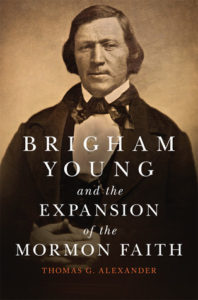 Title: Brigham Young and the Expansion of the Mormon Faith
Title: Brigham Young and the Expansion of the Mormon Faith
Author: Thomas G. Alexander
Publisher: University of Oklahoma Press
Genre: 19th Century, LDS History & Biography
Year Published: 2019
Hardcover, 416, pages
Reviewed by David L. Cook
Since 1987 we have lived just a few miles from where Brigham Young spent his early married years in Mendon, NY. I’ve spent many years learning the history of Brigham and his best friend Heber Kimball, my 3rd great maternal grandfather. My wife and I owned the Tomlinson Inn in Mendon where Brigham gave his first sermon the week after he had officially become a member of the new movement. As stake president I set apart newly called missionaries in the room where Brigham gave that sermon. None of the Brigham Young biographies dedicate much space to the New York years. Although Palmer did do a short history of the New York period and Steve Schwendiman did an exhaustive 4 vol. history on all the LDS from that early branch in Mendon. But I digress.
Thomas G. Alexander is a first-rate historian and an outstanding writer who trained under Leonard Arrington during the so called “Camelot” years in the LDS Church History Department. There have been several great Brigham Young biographies (by Arrington, Bagley, Turner, and Hirshon). Alexander’s is among the best. Alexander is a devoted LDS, yet he takes on the tough questions with independence. All historians find blemishes and contradictions in their subjects and Brigham’s are on display but not excused. Brigham’s strengths and accomplishments appear with equal honesty.
At age 16 Brigham was forced by circumstance to grow up fast as his father told him it was time to make his own way in the world. The Youngs were a religious group which undoubtedly led to their quick acceptance of Mormonism. Although Brigham was the last of the clan to be baptized. The story is faced paced from Brigham’s conversion to his missionary work in England with his lifelong friend Heber Kimball, to Young’s putative head of the church in Nauvoo, IL, after the murder of Joseph Smith by a mob, and the trek to the Utah Territory. The Mountain Meadows Massacre is masterfully covered by Alexander. His treatment is among the best I have read of this complex deeply troubling story. Aside from Turley and Walker, Alexander probably has the deepest analysis of the horrific tale. He pulls no punches and describes in detail the volatile time period and environment. Brigham is often remembered for polygamy and his folksy and sometimes fiery preaching; this book goes way beyond the traditional topics and explores his political acuity as governor and addresses the challenges of governing and his role as a spiritual leader. The final chapters address the challenges Brigham faced with dissent from within with the rise of the short lived Godbeite movement and the hostile federal government. Alexander divides Young’s life into his time as one of Joseph Smith’s reliable deputies, and then as a successful religious and political leader in his own right. The work highlights instances of Young’s pragmatism and adaptability, such as his sometimes changing views on governance and doctrine. Of all the biographies I think Alexander does the best describing the tensions with Native Americans and the United States Government.
Like so many great individuals of history Brigham was complicated. Capable of compassion and theological brilliance as well as being fiery and harsh at times. One of my favorite stores of Brigham was when he was heading West again after one of his many trips East, when his party spotted the unusual sight of a few wagons heading East. He crossed the Platte river only to find an LDS party who decided Utah was not “The Place” for them. Brigham proceeded to dress them down and condemn them. Then he looked at their provisions and condition and in compassion outfitted them with all the needed supplies to get them to their destination and wished them well. That story encapsulates the man–strong, sometimes dogmatic, flexible, fiery, but compassionate.
There is a spot in Mendon, NY called Tomlinson Corners where the Kimballs and Youngs lived. It is the highest point in the county. It is also near the spot where the Youngs and the Kimballs saw what they described as a vision in the night sky the night Joseph Smith received the plates 17 miles to the Northeast on Sept. 22, 1827. There is a small cemetery where Brigham’s wife and Heber’s grandfather are buried. They lived there when the land was being cleared of its old growth forest. In my mind’s eye I see Brigham and Heber with their wagons loaded stopping by the cemetery to pay their last respects looking out over the valley and heading west with no idea what the future would bring. Two uneducated craftsman who would have a profound impact on the future of Mormonism. As far as we know Brigham never returned to Mendon. Had they stayed in New York there may have been a small paragraph or two written about them in local histories but for the most part they would have been forgotten. Oh, how that pivotal decision changed the course of their lives and the Church.
For my friends looking for a Brigham Young biography, I most highly recommend Turner’s and Alexander’s.
